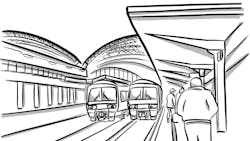Passenger rail operators continue to deploy a variety of strategies to strengthen infrastructure, reduce greenhouse gas emissions and update rolling stock as they work to regain ridership. Several agencies have set recent post-pandemic ridership records, including Metrolink recording its highest weekend ridership in agency history. The agency saw the highest number of weekend customer boardings during March, beating the previous record set in September 2018. That marked the first time Metrolink’s ridership exceeded a pre-pandemic milestone.
However, these ridership gains are still somewhat outliers. Passenger rail ridership has seen modest improvements and trails behind bus ridership. Throughout 2023, rail ridership grew by eight percentage points relative to 2019, ending the year at 70 percent. Heavy rail and light rail were at 70 and 73 percent of 2019 ridership levels, respectively, and commuter rail ended 2023 at 65 percent of pre-pandemic levels, according to an American Public Transportation Association’s (APTA) policy brief released in April 2024. In 2024, APTA’s Public Transportation Ridership Report revealed modest ridership gains continued across all modes: heavy rail ridership increased by three percent, light-rail ridership increased by 6.9 percent and commuter rail ridership increased by 8.2 percent.
Services coming to new communities—some for the first time—can help continue to bolster these ridership numbers. Some of these launches within the past year come with new service schedules and updated fare products, helping to cater to a wider variety of riders. New rolling stock provides opportunities to improve the passenger experience and increase safety features, such as pre-installed security cameras and crash energy management systems.
Passenger rail service reaches new communities
This year has already seen the launch of several new passenger rail services throughout the country, spanning from the East Coast to the West Coast, as well as Canada.
On the East Coast, revenue service on the Massachusetts Bay Transportation Authority’s (MBTA) South Coast Rail began March 24. The service launch marked the first time in over 65 years areas in Southeastern Massachusetts can access passenger rail service to and from downtown Boston.
Out on the West Coast, on Aug. 28, 2024, TriMet celebrated the opening of the MAX Red Line extension, which now operates into Hillsboro, Ore. The extension was one of TriMet’s biggest light-rail projects in nearly a decade and served as the final piece of the three-year, two-phased project, A Better Red.
In Canada, OC Transpo began service on O-Train Lines 2 and 4 at the start of the year. The new lines provide north-south connections, linking neighborhoods, hospitals, universities and offering a direct connection to Ottawa International Airport. The lines also feature larger platforms with modernized designs to increase safety and the travel experience.
Finally, on June 7, Valley Metro will open its South Central Extension/Downtown Hub light-rail project. Operating between downtown Phoenix, the 5.5-mile extension will introduce a two-line rail system that intersects at the new transit hub downtown. The extension will serve an area where 44 percent of residents have limited or no access to personal vehicles.
Agencies invest in updated rolling stock
In addition to the new service launches and extensions, several agencies are introducing new rolling stock into their fleet.
Dynamic testing began on the Maryland Department of Transportation Maryland Transit Administration’s Purple Line light-rail vehicles. Testing on all eight vehicles is confined to the test track before eventually moving to longer sections of the mainline track. Testing is anticipated to last into 2026 as new light-rail vehicles are received.
TransLink started field testing its next-generation Mark V SkyTrain vehicles March 8. The intermittent testing is scheduled during non-peak hours to evaluate the vehicles’ onboard systems, performance on the Expo and Millennium lines and upgrades made to stations to accommodate the longer five-car design.
Riders on New York City Transit’s (NYCT) G Line now have a 15 percent chance of riding in an open-gangway car after the agency launched two new open-gangway trains in March. The R211 subway cars are part of NYCT’s modernization initiative and feature wider door openings, digital displays and pre-installed security cameras.
Back on the West Coast, North County Transit District celebrated its 30th anniversary with the launch of new COASTER passenger cars. These new bi-level coaches and cabs include crash energy management protection systems, better monitoring systems, enhanced door operations and increased security for engineers operating the train.
Rail electrification gains traction
As agencies invest in upgrading their rolling stock, interest in implementing electric and dual-mode locomotives continues to grow. From San Francisco to Boston, operators are procuring and introducing new locomotives that improve the passenger experience while reducing pollution.
Caltrain’s electric fleet, which debuted in August 2024, is outperforming initial projections thanks to the regenerative braking system. The agency is looking at a revised annual cost estimate of $16.5 million—down from $19.5 million. Caltrain credits the reduced cost to the approximately 23 percent of energy the regenerative braking system is sending back to the electrical grid.
In February 2024, Metra signed a $154 million contract with Stadler for a base order of eight two-car, battery-powered trainsets, including engineering, training and spare parts. STV was selected a year later to provide procurement support, including quality assurance, engineering and administrative services. Metra expects the first trainsets to be delivered between 2027-2028, which will be introduced on the Rock Island Line. The Battery Electric Multiple Unit (BEMU) rail vehicles are expected to have a range of 45 to 65 miles.
Keolis Commuter Services (Keolis) plans to electrify the MBTA’s Fairmount Line. Keolis, the operator of MBTA’s Commuter Rail, issued a request for proposals for seven new BEMU trains that can operate with an overhead catenary system and onboard traction batteries. Keolis anticipates the BEMUs entering service in 2028.
Metro-North Railroad is transitioning to cleaner locomotives as well. The SC42-DMs, unveiled in November 2024, are expected to enter revenue service on select branches later this year. The new locomotives are expected to operate in electric mode the entire 102 miles of Metro-North’s third rail territory—unlike the P32s that only operate under electric power in the four miles in the tunnel in and out of Grand Central Terminal. The SC42-DMs are Tier IV compliant and reduce airborne pollutants by more than 85 percent while operating in diesel mode.
Climate change impacts rail service and infrastructure
In addition to agencies seeking preemptive measures to reduce their greenhouse gas emissions through fleet electrification, they’re also working to fortify their infrastructure to ensure service continues to operate smoothly. Agencies are grappling with storm surges, coastal erosion and extreme heat to name a few climate effects.
For instance, the Orange County Transportation Authority (OCTA) has been studying the best approach to protect the Los Angeles – San Diego – San Luis Obispo Rail Corridor from storm surges, coastal erosion and bluff failures. Passenger rail service in this corridor has been suspended off and on at least six times in the past four years. Last year, OCTA had to suspend service to clear debris from the right-of-way following a landslide. OCTA announced another six-week service suspension in April 2025 to perform emergency work to stabilize the slope and protect the track. This time around, the agency is performing riprap repair and sand placement north of Mariposa Point and removal of the remaining pedestrian bridge at Mariposa Point. OCTA continues to work with experts and its partners to find long-term solutions to protect the Southern California coastal rail corridor.
Over in New York, the Metropolitan Transportation Authority’s Metro-North Hudson Line Climate Resilience Blueprint is designed to protect the Hudson Line from climate change effects, such as stormwater runoff, tidal floods and other risks. The blueprint calls for rebuilding critical infrastructure, including culverts, drainage, retaining walls, slopes, shorelines and track and ensures a coordinated approach for all future projects. The blueprint outlines guidance on projects ranging from target track elevations and standards for waterfront shorelines improvements to performance criteria for drainage.
Last summer, Amtrak and New Jersey Transit (NJ Transit) operations suffered serious service disruptions due to aging infrastructure that was further exacerbated by extreme heat. Since then, the two agencies have coordinated a joint inspection, maintenance and improvement program. The joint plan takes a holistic approach to examine Amtrak’s infrastructure in the Northeast Corridor, including the electric traction system, the catenary system, signals and switches, and NJ Transit’s equipment like the pantograph system.
In the most recent progress report, Amtrak completed over 9,500 hardware replacements and three substation improvements, with work planned for eight others throughout 2025. NJ Transit and Amtrak also enhanced contingency response plans for heat situations, including the strategic placement of protect crews and heat forecast-triggered catenary inspections. Amtrak also designated its summer readiness preparation protocols to be preemptive activities scheduled for completion prior to May 31. These activities use data, Amtrak past practices and international best practices to help mitigate common heat failures.
Status on high-speed rail projects
High-speed rail projects in California and Texas have seen some progress, which may be dampened depending on findings from the federal government. In February 2025, the California High-Speed Rail Authority came under review by the Federal Railroad Administration (FRA) following direction from U.S. Department of Transportation Secretary Sean Duffy to evaluate if the nearly $4 billion federal funding should remain committed to the high-speed rail project. Then, in April, FRA terminated its grant agreement with Amtrak under the Corridor Identification and Development Program for the Amtrak Texas High-Speed Rail Corridor, previously known as the Texas Central Railway project.
There’s still interest in the Texas project from the private sector, and California continues to report project updates, so it is too early to tell how the federal directives will fully impact the high-speed rail projects.
About the Author
Megan Perrero
Editor in Chief
Megan Perrero is a national award-winning B2B journalist and lover of all things transit. Currently, she is the Editor in Chief of Mass Transit magazine, where she develops and leads a multi-channel editorial strategy while reporting on the North American public transit industry.
Prior to her position with Mass Transit, Perrero was the senior communications and external relations specialist for the Shared-Use Mobility Center, where she was responsible for helping develop internal/external communications, plan the National Shared Mobility Summit and manage brand strategy and marketing campaigns.
Perrero serves as the board secretary for Latinos In Transit and is a member of the American Public Transportation Association Marketing and Communications Committee. She holds a bachelor’s degree in multimedia journalism with a concentration in magazine writing and a minor in public relations from Columbia College Chicago.

